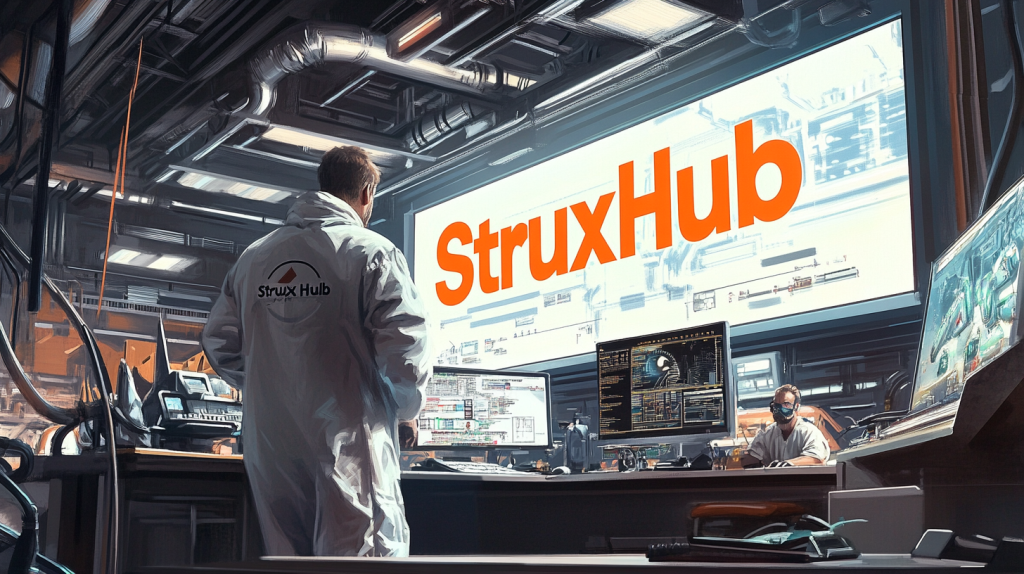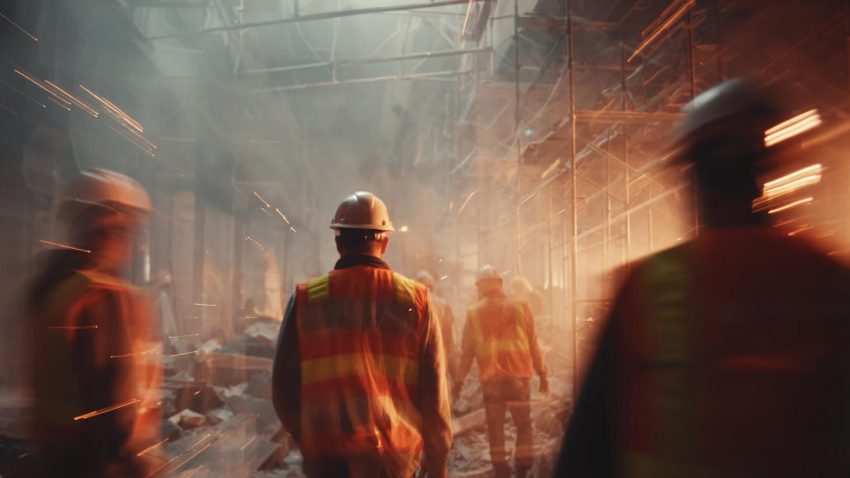Top Job Hazard Analysis (JHA) Practices That Help Contractors Pass Safety Audits With Confidence
Table of Contents:

Every superintendent knows that a well-prepared Job Hazard Analysis (JHA) can make or break a safety audit. A JHA isn’t just a formality—it’s a detailed breakdown of how each task on a jobsite will be performed safely, step by step. When done right, it builds trust with owners, keeps crews aware of potential hazards, and demonstrates to auditors that your safety culture runs deep, not just on paper.
In today’s fast-moving projects—especially in data centers, industrial builds, and mission-critical facilities—safety documentation must be accurate, timely, and accessible. Auditors expect consistency between what’s written in the JHA and what’s actually happening in the field. That means digital tools, real-time updates, and clear crew communication are no longer “nice to have”—they’re essential.
This article breaks down the top JHA practices that contractors and superintendents use to stay compliant, improve audit scores, and reduce incident risk. You’ll learn how digital JHAs simplify review processes, the steps to standardize hazard controls, and how StruxHub helps streamline every part of your jobsite safety workflow.
How Job Hazard Analyses Keep Crews and Auditors Aligned
A JHA starts as a safety document but quickly becomes a daily roadmap for how crews operate. When every step of a task is analyzed for potential hazards—and those hazards are mitigated before work begins—everyone benefits. Crews gain clarity on what’s expected, superintendents can verify controls in real time, and auditors see a strong safety system in action.
Inconsistent or outdated JHAs are one of the main reasons safety audits fail. When a field team uses yesterday’s version or doesn’t sign off properly, gaps appear. Modern JHA management focuses on accessibility—using digital tools that automatically update versions, timestamps, and approvals across all devices. This not only prevents confusion but also creates a digital trail that proves compliance during inspections.
Top Benefits
- Reduces risk of missing or outdated hazard controls during field inspections
- Builds trust and transparency with owners and safety officers
- Provides an auditable digital record for safety compliance and certifications
Best Practices
- Review JHAs daily during morning safety meetings before any new task begins
- Use digital platforms that timestamp sign-offs and store audit history automatically
- Assign clear ownership for updating and closing out each JHA section
Q&A Mini Section
Q: What’s the biggest reason JHAs fail audits?
A: Missing documentation or outdated forms—often due to manual paper tracking.
Q: Should crews participate in creating JHAs?
A: Yes, involving field crews improves accuracy and helps ensure real-world hazards are identified early.
Q: How often should JHAs be reviewed?
A: At least daily, or whenever a new scope or condition changes the original task plan.
When JHAs are integrated into daily workflows rather than treated as checklists, they foster accountability and readiness—two traits auditors value most during site evaluations.

Standardizing JHA Templates for Consistency Across Projects
Contractors working across multiple sites often struggle with JHA consistency. Each foreman or project manager might use slightly different formats, which complicates audits and reporting. Standardization fixes that. A consistent JHA format ensures that auditors can easily verify controls, compare jobsite data, and confirm that your safety standards meet regulatory requirements across the board.
The best JHA templates are detailed but easy to complete. They should clearly outline each task, hazard, and control measure while leaving room for project-specific notes. Digital JHA systems let safety managers build and distribute standardized templates that field crews can complete directly from mobile devices, reducing time and human error. This also keeps project teams unified under one compliance framework—something auditors look for immediately.
Top Benefits
- Ensures uniform documentation across multiple projects and subcontractors
- Speeds up audit reviews by maintaining a predictable format
- Reduces training time for new employees who can follow consistent procedures
Best Practices
- Create one master JHA template aligned with OSHA and owner requirements
- Use dropdown fields and auto-fill features to prevent missing data
- Train new hires using real-world JHA examples from active projects
Q&A Mini Section
Q: Why is JHA standardization so important for large contractors?
A: It allows uniform compliance and easier reporting across multiple jobsites.
Q: Can JHA templates be too detailed?
A: Yes—avoid cluttering with unnecessary sections. Keep it precise and actionable.
Q: What’s the easiest way to manage multiple JHA versions?
A: Use cloud-based software that tracks version history and user edits automatically.
When every team uses the same structure, it’s easier to monitor, update, and validate—ensuring your entire safety program feels seamless to both field teams and auditors.
Digital JHA Tools and Real-Time Verification During Safety Audits
Gone are the days of binders and clipboards. Modern safety audits require instant access to verified documentation. Digital JHA platforms give superintendents and safety officers the ability to review, update, and sign forms in real time. This level of visibility keeps safety data transparent, reduces administrative work, and helps prove compliance instantly when auditors request evidence.
During audits, time matters. Instead of sorting through paper forms, superintendents can pull up completed JHAs on tablets—showing timestamps, crew signatures, and hazard control updates for each work activity. These records often include photo attachments or field notes that reinforce what’s been done on site. Combined with cloud-based backups, these features build a defensible record that demonstrates ongoing compliance.
Top Benefits
- Enables instant proof of compliance during inspections
- Minimizes lost or incomplete paperwork through digital recordkeeping
- Improves crew accountability with real-time signature tracking
Best Practices
- Upload photos or field verifications directly to JHA entries
- Use mobile dashboards to confirm daily crew sign-offs before work starts
- Maintain cloud archives for all completed JHAs for a minimum of 3 years
Q&A Mini Section
Q: Can digital JHAs be used during official OSHA audits?
A: Yes, digital records are fully accepted as long as they’re complete and timestamped.
Q: How does real-time verification help?
A: It allows instant confirmation that safety controls are in place—no waiting for paperwork.
Q: What’s the best way to train crews on using digital JHAs?
A: Start with short daily demonstrations; keep it simple and repeat until it becomes habit.
Digital tools make compliance effortless and verifiable. They not only protect the contractor from citations but also demonstrate a proactive safety culture that stands out during every audit.
How Field Supervisors Use JHAs to Lead Safety Meetings
A JHA isn’t just paperwork—it’s a teaching tool. When field supervisors use JHAs during morning huddles, they transform a compliance form into a live conversation about risk awareness. Instead of reciting a checklist, the foreman can highlight the hazards of the day, point to real work zones, and get every crew member involved in spotting and discussing potential issues. This interaction turns a “form requirement” into a shared safety mindset.
Effective JHA-based safety meetings keep things visual and specific. Supervisors can display JHAs on tablets, reference photos, and show the controls planned for the day’s work. This level of communication gives workers confidence and clarity about what’s expected. When auditors interview crews, those clear and consistent responses reflect a team that understands safety deeply—not one that memorized answers.
Top Benefits
- Encourages two-way communication between supervisors and crews
- Builds consistent awareness of daily hazards and mitigation strategies
- Reinforces accountability—crews sign off knowing the plan was reviewed together
Best Practices
- Integrate JHA reviews into every pre-task or toolbox meeting
- Use visuals, such as marked-up photos or drawings, to explain hazards
- Rotate who reads sections aloud so every team member stays engaged
Q&A Mini Section
Q: Should JHAs replace toolbox talks?
A: Not exactly—they complement each other. The JHA is task-specific, while toolbox talks cover broader safety themes.
Q: How long should a JHA review take?
A: Usually five to ten minutes—long enough to ensure understanding without slowing progress.
Q: What makes JHA-based meetings more effective?
A: Interactive discussion and visual examples keep crews alert and invested in their own safety.
By making JHAs the centerpiece of daily safety talks, field supervisors strengthen both compliance and crew engagement—an unbeatable combination during any safety audit.
How JHAs Support Owner and Third-Party Safety Audits
Safety auditors don’t just inspect worksites—they assess systems. A well-documented JHA framework shows that safety isn’t reactive but embedded into every phase of construction. When owners or third-party safety officers visit, having clear JHA records demonstrates that every activity was pre-planned with risk controls and worker participation in mind.
Auditors often focus on traceability: who created each JHA, when it was reviewed, and whether corrective actions were logged. Digital JHA management systems allow contractors to present these answers instantly. The ability to cross-reference field notes, photos, and electronic signatures in seconds can make the difference between a pass and a re-inspection. Owners appreciate seeing proactive transparency—it signals reliability and professionalism.
Top Benefits
- Builds confidence with owners by proving proactive hazard management
- Reduces risk of failed inspections through documented traceability
- Simplifies data sharing with third-party auditors and safety consultants
Best Practices
- Prepare JHA summaries for high-risk work scopes before audits begin
- Use timestamps and sign-offs to verify that JHAs are current and reviewed
- Provide owners access to read-only JHA dashboards for real-time transparency
Q&A Mini Section
Q: What do owners look for most in JHA reviews?
A: Consistency—proof that every trade follows the same process across shifts.
Q: Can third-party auditors access digital JHA platforms?
A: Yes, many platforms allow secure guest access for limited viewing.
Q: How do digital JHAs improve audit response time?
A: They eliminate searching through binders—everything is indexed and instantly retrievable.
When owners see a seamless digital trail of safety diligence, it reinforces trust and positions your team as a partner that takes compliance seriously.

StruxHub
Experience the power of StruxHub today and witness firsthand how it can revolutionize your construction operations.
Building a Continuous Improvement Culture Around JHA Reviews
The most successful contractors treat JHAs as evolving documents, not one-time submissions. Continuous improvement means learning from every audit, every incident report, and even near-misses. When supervisors revisit JHAs regularly and update hazard controls based on lessons learned, safety becomes a living process rather than static paperwork.
Creating this culture requires leadership commitment. Encourage teams to flag outdated procedures or suggest better mitigation strategies. Schedule recurring safety reviews where recent JHAs are discussed, and use that feedback to refine templates and workflows. Over time, this builds a stronger, smarter organization where safety evolves with the jobsite.
Top Benefits
- Strengthens company-wide learning through shared JHA reviews
- Reduces repeated errors by capturing lessons from previous projects
- Keeps safety documentation aligned with changing regulations and site conditions
Best Practices
- Hold quarterly JHA review sessions with cross-trade representation
- Track and trend audit results to pinpoint recurring hazard types
- Reward teams who identify and implement successful control improvements
Q&A Mini Section
Q: How often should JHA processes be audited internally?
A: At least once per quarter, or whenever new equipment or tasks are introduced.
Q: What’s the best way to encourage crew feedback on JHAs?
A: Make it simple—digital comment fields or voice notes encourage more participation.
Q: Why is continuous improvement key to passing audits?
A: Because it proves your system adapts and self-corrects—something auditors value highly.
A feedback-driven safety culture turns JHAs from static forms into dynamic blueprints for jobsite success, boosting both morale and compliance outcomes.
How StruxHub Helps Contractors Manage JHAs and Pass Audits
StruxHub simplifies everything about JHA management—from daily crew reviews to audit preparation. Its digital workflows let superintendents create, assign, and update JHAs directly from the field. Every edit, comment, and sign-off is timestamped, so there’s always a clear record of accountability. When an auditor arrives, all documentation is just a few clicks away.
StruxHub also integrates safety forms with other site management tools—like Pre-Task Plans, Delivery Logs, and Daily Reports—making it easy to connect hazards to real work activities. That linkage gives contractors the full picture of how safety, scheduling, and field coordination work together. Whether you’re preparing for an owner walkthrough or an OSHA inspection, StruxHub ensures nothing falls through the cracks.
Top Benefits
- Centralizes all JHA records with searchable digital access
- Streamlines crew sign-offs and verification through mobile devices
- Connects safety data with project scheduling and daily reporting tools
Best Practices
- Use StruxHub’s mobile checklists to review JHAs before each shift
- Tag completed JHAs to corresponding daily reports for easy audit retrieval
- Invite owners or safety auditors to view JHAs through secure guest access
Q&A Mini Section
Q: Can StruxHub replace standalone safety apps?
A: Often yes—its unified platform covers documentation, coordination, and reporting.
Q: Does StruxHub store completed JHAs for long-term compliance?
A: Absolutely, with cloud backups and export options for permanent recordkeeping.
Q: How does StruxHub improve audit readiness?
A: By linking every JHA to its work activity, signatures, and timestamps, ensuring instant proof of compliance.
With StruxHub, contractors gain a reliable, transparent system for managing safety documentation—helping teams stay prepared, compliant, and confident on every audit day.

FAQ: Job Hazard Analysis (JHA) in Construction Safety Audits
StruxHub
Discover how StruxHub can revolutionize your construction management. Contact us today!
1. What is the main purpose of a Job Hazard Analysis (JHA) in construction?
A Job Hazard Analysis (JHA) helps identify potential hazards before work begins, ensuring that every task is planned and executed safely. It’s a proactive process that breaks down each activity into steps, then evaluates risks such as falls, electrical exposure, or equipment operation. By defining hazard controls upfront, JHAs reduce the likelihood of incidents and reinforce accountability across the team. For superintendents and contractors, JHAs also create documentation that demonstrates compliance with OSHA and owner safety standards. When properly managed, a JHA functions as both a prevention tool and an audit-ready record, showing that every crew member was informed, trained, and signed off before starting work. The best companies treat JHAs as living documents—updated daily as conditions change—so their safety programs stay ahead of evolving risks.
2. How can digital JHA platforms improve safety compliance and audit readiness?
Digital JHA tools eliminate the chaos of paper forms by keeping all documentation in one place. They allow supervisors to create, review, and update JHAs from mobile devices, ensuring that everyone always works off the most current version. During safety audits, digital records make compliance easy to prove. Every edit, approval, and signature is timestamped, providing auditors with a transparent view of the contractor’s safety management process. Additionally, photos and notes can be attached directly to each hazard control, creating verifiable field evidence. Digital systems also automate version control, send reminders for overdue reviews, and link JHAs to related reports like Pre-Task Plans or Daily Logs. The result is less administrative burden, faster audits, and stronger documentation—helping teams stay compliant with confidence.
3. What should contractors include in a JHA to pass safety audits successfully?
A compliant JHA should include clear task descriptions, identified hazards, and corresponding mitigation measures. Each section must list who performed the analysis, when it was completed, and which crew members reviewed and signed off. Auditors look for thoroughness—whether potential risks are realistically addressed—and consistency with observed jobsite conditions. Contractors should also include references to safety data sheets, PPE requirements, and related site plans when relevant. The best JHAs are concise but comprehensive, showing both awareness and control. Digital templates make this easier by enforcing required fields, preventing missing information, and ensuring every signature is captured. A strong JHA shows not only that hazards were identified but that corrective actions were implemented before work began—something every safety auditor wants to see.
4. How often should Job Hazard Analyses be updated on active construction sites?
JHAs should be reviewed daily or whenever a new scope of work, crew member, or condition changes. A jobsite evolves constantly—equipment moves, weather shifts, and tasks overlap. Outdated JHAs are a major audit red flag, as they imply the contractor isn’t actively monitoring safety. Most superintendents include JHA reviews as part of daily morning meetings, ensuring every worker understands what’s changed and what remains the same. When using digital platforms, updates can be made instantly and shared across all devices. These updates automatically record the date, time, and responsible person, maintaining a traceable log of compliance. The goal is to make JHA updates a natural part of the construction rhythm—continuous, accurate, and aligned with real-time field conditions.
5. How does StruxHub simplify JHA management and audit preparation for contractors?
StruxHub integrates safety documentation directly into daily project management workflows, removing the friction between fieldwork and compliance. Superintendents can create and update JHAs on-site, capture signatures instantly, and attach photos for verification—all within the same platform they use for scheduling and reporting. The system automatically timestamps every update and stores data in the cloud for future reference. When auditors arrive, contractors can instantly pull up JHAs by date, activity, or crew, proving compliance without digging through binders. StruxHub also connects JHAs to related modules like Pre-Task Plans and Daily Reports, giving safety managers a complete picture of project readiness. By combining convenience with accountability, StruxHub turns safety documentation from a time-consuming task into an efficient, audit-ready process that demonstrates genuine commitment to jobsite safety.

StruxHub
Discover how StruxHub can revolutionize your construction management. Contact us today!
Related Pillar Articles:
Best Guide to Construction Logistics Plans (CLPs): What Owners Want to See Before Work Starts



